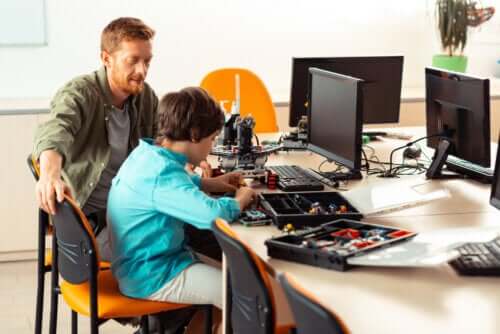What Is STEM Education?


Written and verified by the psychologist Ana Couñago
STEM is an acronym that comes from the terms Science, Technology, Engineering and Mathematics. Thus, STEM education encompasses these four spheres of knowledge, teaching them in a comprehensive, interdisciplinary and realistic way.
So, the aim of this type of innovative education is to train, from the first years of schooling, future citizens capable of successfully facing life in the 21st century.
“Education is not preparation for life; education is life itself.”
— John Dewey —
What is STEM education?
STEM (Science, Technology, Engineering and Mathematics) education is based on the development of skills, knowledge and practices related to the fields of:
- Science: the study of the natural, social, physical, etc., environment.
- Technology: the creation of tools or products to satisfy people’s desires and needs.
- Engineering: the process of designing and building objects and systems to solve problems.
- Mathematics: the use of language of numbers, shapes and quantities to address logical problems and mental challenges.

“We will always have STEM with us. Some things will drop out of the public eye and disappear, but science, engineering, and technology will always be there. And mathematics will always be there, always.”
— Katherine Johnson —
It’s worth noting that, according to STEM education, it’s necessary to apply the information acquired about these four disciplines to real-world problems, situations and challenges. As a result, this method makes the information useful, relevant and meaningful.
Objectives of this innovative education
Thus, the main objectives of STEM education are:
- To enhance the skills and love for science, technology, engineering and mathematics in children and young people.
- To foster critical thinking, problem-solving skills, creativity, innovation, collaboration, research, leadership and teamwork among students.
- Respond to the economic and labor challenges present today and in the near future, allowing the advancement of society. Thus, according to DigitalES, the Spanish Association for Digitalization, today there are at least 10,000 vacant jobs in the technology sector in Spain due to lack of qualification. In addition, estimates show that between 2017 and 2022, digitalization will create 1,250,000 jobs in this country.
- To make students scientifically, mathematically and digitally literate. Also to address the need to solve the technological and environmental problems of today’s world. Consequently, new generations will understand, take part, make decisions and solve the scientific-technological challenges of our society.
- To break gender stereotypes and involve girls to a greater extent, so that they develop an interest in STEM. According to the UNESCO world report “Cracking the Code: Girls’ and Women’s Education in Science, Technology, Engineering and Mathematics (STEM)”, only 35% of students in STEM-related degrees in higher education are women. From this small group, only 3% decide to study in the field of information and communication technologies (ICT).

How to teach according to STEM education?
According to STEM education, lessons must have both theoretical and practical aspects, so that students assimilate the basic concepts and contents of the different disciplines, and then apply them to solve real, everyday problems. In addition, research and exploration of different STEM fields should be included.
So, in order to successfully carry out these tasks or challenges, creativity (flexibility, originality and fluency) is needed. Consequently, this leads to innovation. And, of course, it’s necessary to convey the idea that trial and error are part of the teaching-learning process.
Finally, it’s also important to use a methodology that is based on teamwork, as this is a skill that is in great demand nowadays.
STEM is an acronym that comes from the terms Science, Technology, Engineering and Mathematics. Thus, STEM education encompasses these four spheres of knowledge, teaching them in a comprehensive, interdisciplinary and realistic way.
So, the aim of this type of innovative education is to train, from the first years of schooling, future citizens capable of successfully facing life in the 21st century.
“Education is not preparation for life; education is life itself.”
— John Dewey —
What is STEM education?
STEM (Science, Technology, Engineering and Mathematics) education is based on the development of skills, knowledge and practices related to the fields of:
- Science: the study of the natural, social, physical, etc., environment.
- Technology: the creation of tools or products to satisfy people’s desires and needs.
- Engineering: the process of designing and building objects and systems to solve problems.
- Mathematics: the use of language of numbers, shapes and quantities to address logical problems and mental challenges.

“We will always have STEM with us. Some things will drop out of the public eye and disappear, but science, engineering, and technology will always be there. And mathematics will always be there, always.”
— Katherine Johnson —
It’s worth noting that, according to STEM education, it’s necessary to apply the information acquired about these four disciplines to real-world problems, situations and challenges. As a result, this method makes the information useful, relevant and meaningful.
Objectives of this innovative education
Thus, the main objectives of STEM education are:
- To enhance the skills and love for science, technology, engineering and mathematics in children and young people.
- To foster critical thinking, problem-solving skills, creativity, innovation, collaboration, research, leadership and teamwork among students.
- Respond to the economic and labor challenges present today and in the near future, allowing the advancement of society. Thus, according to DigitalES, the Spanish Association for Digitalization, today there are at least 10,000 vacant jobs in the technology sector in Spain due to lack of qualification. In addition, estimates show that between 2017 and 2022, digitalization will create 1,250,000 jobs in this country.
- To make students scientifically, mathematically and digitally literate. Also to address the need to solve the technological and environmental problems of today’s world. Consequently, new generations will understand, take part, make decisions and solve the scientific-technological challenges of our society.
- To break gender stereotypes and involve girls to a greater extent, so that they develop an interest in STEM. According to the UNESCO world report “Cracking the Code: Girls’ and Women’s Education in Science, Technology, Engineering and Mathematics (STEM)”, only 35% of students in STEM-related degrees in higher education are women. From this small group, only 3% decide to study in the field of information and communication technologies (ICT).

How to teach according to STEM education?
According to STEM education, lessons must have both theoretical and practical aspects, so that students assimilate the basic concepts and contents of the different disciplines, and then apply them to solve real, everyday problems. In addition, research and exploration of different STEM fields should be included.
So, in order to successfully carry out these tasks or challenges, creativity (flexibility, originality and fluency) is needed. Consequently, this leads to innovation. And, of course, it’s necessary to convey the idea that trial and error are part of the teaching-learning process.
Finally, it’s also important to use a methodology that is based on teamwork, as this is a skill that is in great demand nowadays.
All cited sources were thoroughly reviewed by our team to ensure their quality, reliability, currency, and validity. The bibliography of this article was considered reliable and of academic or scientific accuracy.
- Bogdan, T. y Greca, I. M. (2016). Modelo interdisciplinar de educación STEM para la etapa de Educación Primaria. Burgos: Universidad de Burgos.
- Nerstheimer, K., Bielefeld, K. , Scribner, D. y Rink, T. (s.f). La Gran Guía de STEM. Boxlight Mimio. Recuperado de: https://lanews.boxlight.com/guia-stem-0
This text is provided for informational purposes only and does not replace consultation with a professional. If in doubt, consult your specialist.








